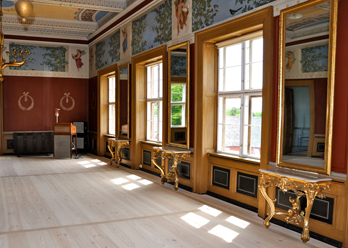Pier table on:
[Wikipedia]
[Google]
[Amazon]
A pier table is a  Above the table there was very often a tall
Above the table there was very often a tall
table
Table may refer to:
* Table (furniture), a piece of furniture with a flat surface and one or more legs
* Table (landform), a flat area of land
* Table (information), a data arrangement with rows and columns
* Table (database), how the table data ...
designed to be placed against a wall, either between two windows or between two columns. It is also known as a console table
A console table is a table whose top surface is supported by corbels or brackets rather than by the usual four legs. It is thus similar to a supported shelf and is not designed to serve as a stand-alone surface. It is frequently used as pier t ...
(french: console
Console may refer to:
Computing and video games
* System console, a physical device to operate a computer
** Virtual console, a user interface for multiple computer consoles on one device
** Command-line interface, a method of interacting with ...
, "support bracket"), although furniture historians differentiate the two types, not always consistently.
 Above the table there was very often a tall
Above the table there was very often a tall pier glass
A pier glass or trumeau mirror is a mirror which is placed on a pier, i.e. a wall between two windows supporting an upper structure.
It is therefore generally of a long and tall shape to fit the space. It may be as a hanging mirror or as mirro ...
on the wall, the two typically made to match.Gloag, 516
The pier table takes its English name from the " pier wall", the space between windows. The table was developed in continental Europe in the 1500s and 1600s, and became popular in England
England is a country that is part of the United Kingdom. It shares land borders with Wales to its west and Scotland to its north. The Irish Sea lies northwest and the Celtic Sea to the southwest. It is separated from continental Europe b ...
in the last quarter of the 1600s. The pier table became known in North America in the mid-1700s, and was a popular item into the mid to late 1800s. It was common for the space between the rear legs of the pier table to contain a mirror to help hide the wall. Later pier tables were designed to stand in any niche in a room.
The pier table may often be semicircular, the flat edge against the wall. Pier tables from later periods are often large and quite ornate. Well-known designers such as Duncan Phyfe
Duncan Phyfe (1768 – 16 August 1854) was one of nineteenth-century America's leading cabinetmakers.
Although he did not create a new furniture style, he interpreted fashionable European trends in a manner so distinguished and particular that ...
, Robert Adam
Robert Adam (3 July 17283 March 1792) was a British neoclassical architect, interior designer and furniture designer. He was the son of William Adam (1689–1748), Scotland's foremost architect of the time, and trained under him. With his o ...
, George Hepplewhite
George Hepplewhite (1727? – 21 June 1786) was a cabinetmaker. He is regarded as having been one of the "big three" English furniture makers of the 18th century, along with Thomas Sheraton and Thomas Chippendale. There are no pieces of furnitu ...
, and Thomas Sheraton
Thomas Sheraton (1751 – 22 October 1806) was a furniture designer, one of the "big three" English furniture makers of the 18th century, along with Thomas Chippendale and George Hepplewhite. Sheraton gave his name to a style of furniture charac ...
all designed and manufactured notable examples of pier tables.
Over time, the pier table evolved into the sideboard
A sideboard, also called a buffet, is an item of furniture traditionally used in the dining room for serving food, for displaying serving dishes, and for storage. It usually consists of a set of cabinets, or cupboards, and one or more drawers ...
.
References
;Notes ;CitationsBibliography
* Gloag, John, ''John Gloag's Dictionary of Furniture'', 1990, London, Unwin Hyman, * * * * {{DEFAULTSORT:Pier table Tables (furniture)